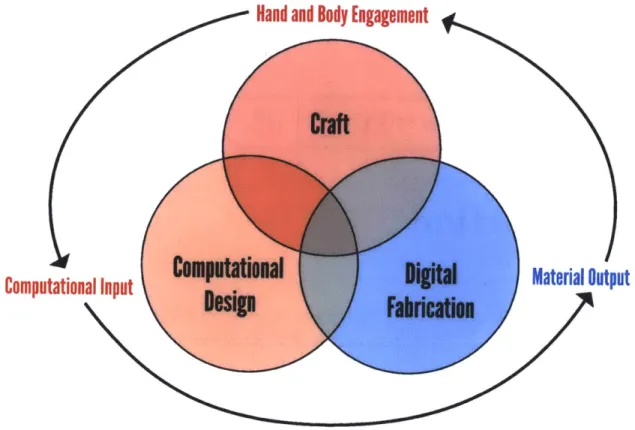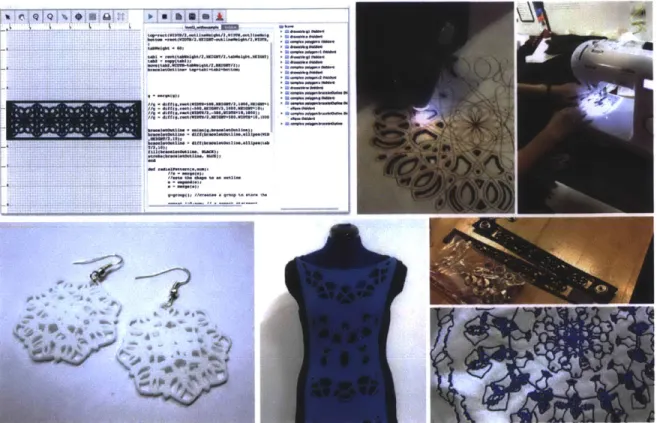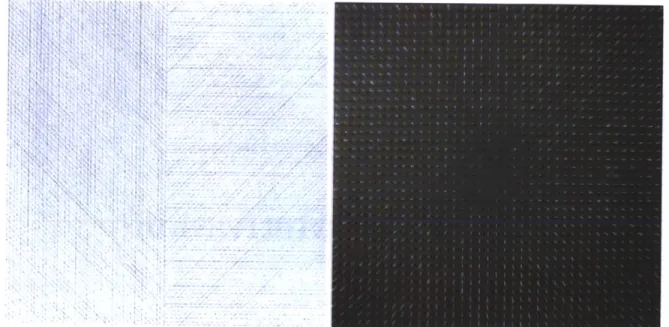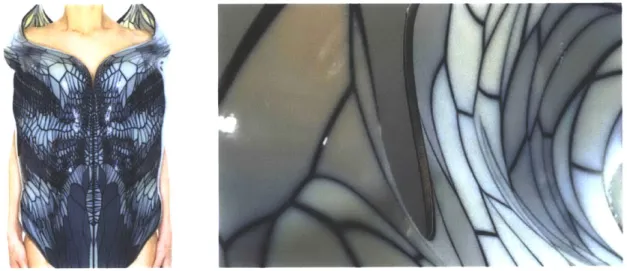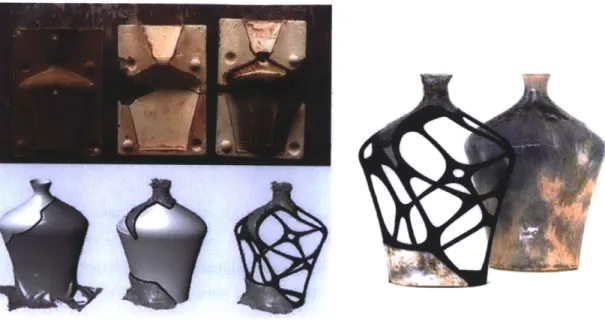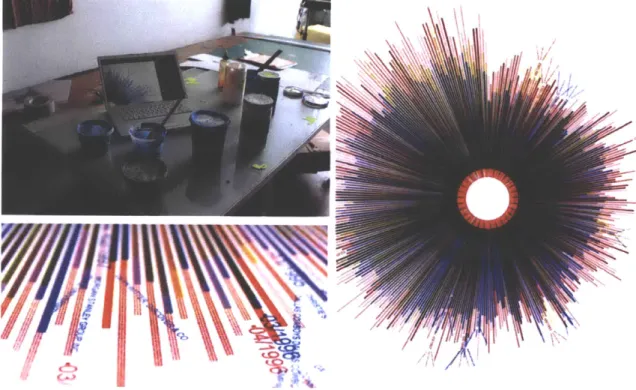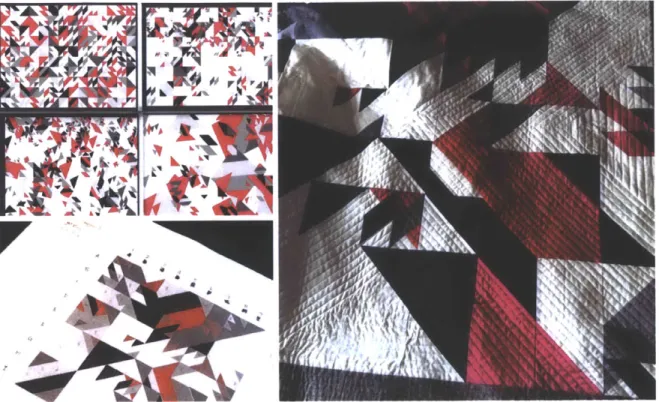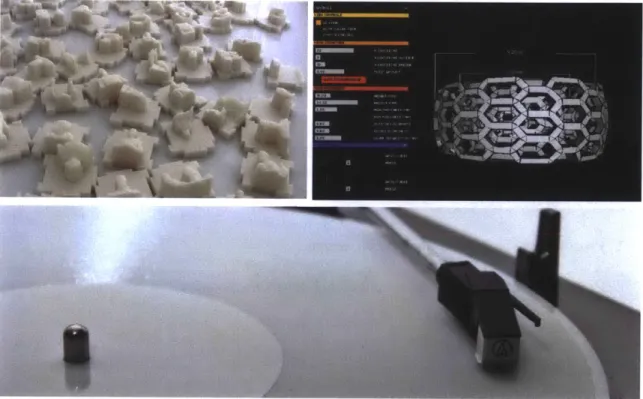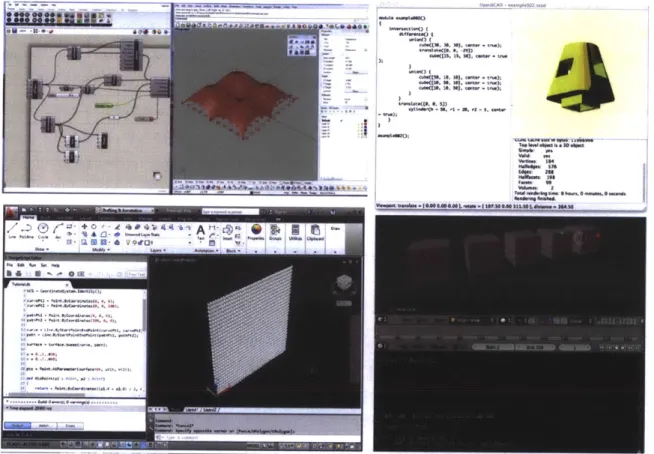Algorithmic Craft: the Synthesis of Computational Design,
Digital Fabrication, and Hand Craft
by
Jennifer Jacobs
AS CHVES
B.F.A., University of Oregon, 2007
OF TECHNOLOGYand
Jut
14
20144
M.F.A., Hunter College, 2011
LIBRARIES
Submitted to the Program in Media Arts and Sciences,
School of Architecture and Planning,
in partial fulfillment of the requirements for the degree of
Master of Science in Media Arts and Sciences
at the
MASSACHUSETTS INSTITUTE OF TECHNOLOGY
September 2013
Massachusetts Institute of Technology 2013. All rights reserved.
Signature redacted
A uthor ...
Prog
i
edia Arts and Sciences
August 5, 2013
Signature redacted
C ertified by ...
7/
Leah Buechvy
AT&T Career Development Professor, Associate Professor
Program in Media Arts and Sciences
Thesis Supervisor
Signature redacted
A ccepted by ...
-Ntie Maes
Alexander W. Dreyfoos (1954) Professor, Associate Academic Head
Program in Media Arts and Sciences
Algorithmic Craft: the Synthesis of Computational Design, Digital
Fabrication, and Hand Craft
by
Jennifer Jacobs
Submitted to the Program in Media Arts and Sciences, School of Architecture and Planning,
on August 5, 2013, in partial fulfillment of the requirements for the degrees of Master of Science in Media Arts and Sciences
Abstract
Programing is a singular creative tool with the potential to support personal expression. Unfor-tunately, many people who are new to programing view it as a highly specialized, difficult and inaccessible skill that is only relevant for career paths in science, engineering, or business fields. De-spite this perception, programing enables novel forms of creative expression and communication in the medium of computation. Visual and physical art, craft, and design are interrelated domains that offer exciting possibilities when extended by computation. By forging strong connections between the skill of programming and the construction of personally relevant physical objects, it may be possible to foster meaningful creative experiences in computation and making for non-professionals. The combination of computational design, digital fabrication, and hand craft to create functional artifacts offers an opportunity to make programing compelling for people with an interest in craft-sensitive forms of making. I define the synthesis of these fields with the term algorithmic craft. This thesis describes my work in developing a set of software tools that attempt to make the practice of algorithmic craft accessible for novice programers. Through it, I describe the design of each tool and discuss my experiences in engaging people in the creation of objects that are imagined by the mind, designed with programming, formed by machines, and shaped by hand.
Thesis Supervisor: Leah Buechley
Title: AT&T Career Development Professor, Associate Professor Program in Media Arts and Sciences
Algorithmic Craft: the Synthesis of Computational Design, Digital
Fabrication, and Hand Craft
by
Jennifer Jacobs
The following people served as readers for this thesis:
T hesis Reader ...
LEGO Papert Professor
T hesis R eader ...
ignature redacted
Mitchel Resnick
of Learning Research, Academic Head
Program in Media rts and Sciences
Signature redacted
Neri Oxman
Sony Corporation Career Development Professor,
ssistant Professor
Program in Me ia Arts and Sciences
Acknowledgments
Many individuals provided support and guidance through the development of this thesis. I would like to express my gratitude to the following people:
I would like to thank my advisor, Leah Buechley, who has been an invaluable mentor and has changed the way I see the world. I would also like to thank my committee members, Mitchel Resnick and Neri Oxman, who both provided insight on how to design creative tools for others.
I would like to thank my fellow members of High-Low Tech and the Media Lab Community. To
Dave Mellis, for providing vital criticism and for forcing me to question my assumptions. To Sam Jacoby for helping me through self-doubt and for his constant willingness to discuss my ideas. To Emily Lovell, who welcomed me into High-Low Tech and supported my ideas. To Jie Qi and Amit Zoran, for inspiring me through their artistry and craftsmanship. To Sean Follmer for providing frequent feedback on my writing and ideas and encouraging me to take time off. To Ricarose Roque, for helping to facilitate my workshop with young people and for giving valuable advice and feedback on my methods. To my UROPs, Yi Tong, Katie Lee and Hannah Pang, who provided vital assistance in software development. I would also like to thank the participants in my early workshops, Nanwei Gong, Nan Zhao, Lining Yao, Tiffany Tseng, Eric Rosenbaum, Dan Beyer, Elliott Hedman, Scott Gilroy, Felicia Davis, Akane Sano, and many others, who graciously put up with buggy software and a sleep-deprived instructor.
Thank you to all.the external organizations that helped with the evaluation of this work. To the members of FUSE, specifically Maggie Waldron and Lauren Penney, for all of their feedback and ideas. To Susan Klimczak of Learn 2 Teach, Teach 2 Learn, for helping with my youth workshops. To the wonderful individuals at DreamYard, for hosting us in their studio, and visiting our lab and providing early feedback on the project.
I would like to thank my family. To my mom and dad, who gave me with my first sewing kit and my first computer when I was young, and have always encouraged and supported my interest in science and art. Thanks also to my brother, whose own work inspires me to find ways of helping other people express themselves.
Lastly, I would like to thank Nicholas Gillian for his support. Thanks for explaining complex algorithms, for listening to my ideas, and for bringing me sandwiches.
Contents
1 Introduction
2 Background and Motivation
2.1 Computational Design . . . . 2.2 Digital Fabrication
2.3 C raft . . . .
2.4 Algorithmic Craft . . . . 2.4.1 Digital Fabrication and Craft . . 2.4.2 Computational Design and Craft 2.5 Challenges in Participation . . . .
3 Related Software Tools and Research
3.1 Programming Tools for Computational Design . . . . 3.2 Professional CAD Tools with Computational-Design Functionality
3.3 Entry-Level CAD Tools . . . .
3.4 Entry-Level Programming Environments . . . .
3.5 Novel Fabrication Tools . . . .
4 Objectives and Evaluation Criteria
4.1 Design Tools and Evaluation Methodology.
5 Codeable Objects 5.1 Motivation . . . 5.2 Tool Description 5.3 Workshops . . . 5.4 Results . . . . 5.5 Discussion . . . . 5.5.1 Challenges 5.6 Summary . . . . 17 21 . . . . 21 . . . . 2 6 28 29 29 30 33 35 35 37 39 40 42 45 46 49 50 51 53 54 55 57 59 . . . . . . . . . . . . . . . . . . . . . . . .
6 Soft Objects 6.1 Motivation 6.2 Tool Description 6.3 6.4 6.5 6.6 6.7 W orkshop . . . .. R esults . . . . ... D iscussion . . . . 6.5.1 Identification as a Programmer . . . .
6.5.2 Application of Computational Affordances .
6.5.3 Aesthetics and Identity Expressed Through 6.5.4 Physical and Digital Connections . . . .
6.5.5 Enthusiasm in Crafting and Coding . . . .
Lim itations . . . .
. .
Summary . . . . . . .
Code
7 DressCode
7.1 Design Principles and Software Features . . . . 7.1.1 Interface Design . . . .
7.1.2 Programming Language . . . .
7.2 Fabrication and Crafting Processes . . . .
7.3 Tool Summary . . . . 7.4 Workshops . . . . 7.4.1 Expert Workshop . . . . 7.4.2 Youth Workshop . . . . 7.5 R esults . . . . .. . 7.5.1 Expert Results . . . . 7.5.2 Youth Results . . . . 7.6 Discussion . . . . ... .
7.6.1 Starting Notions of Craft and Computation
7.6.2 Enjoyment in Programming . . . .
7.6.3 Design Processes . . . . 7.6.4 Algorithmic Aesthetics . . . .
7.6.5 Emergence of Personal Value . . . .
8 Conclusions and Future Directions
8.1 Future Directions . . . . 8.2 Conclusion . . . . . 61 - . .- . . .. . . . . 62 - .. . . .. . . . 64 - .. .. .- . .. . . 65 - . .- . . . . 67 - . . . .. . . . 68 . . . . 68 . . . . 69 . . . . . 71 . . . . 72 . . . . 72 . . .. .- . . . . . 73 . . . .. .- . .. . . 74 77 78 78 80 85 86 87 88 88 91 91 92 93 94 96 98 101 104 109 112 113
A Interview Questions 115
B Full DressCode Language Specifications 117
B.0.1 Interface Design ... ... 117 B.0.2 Programing Language . . . . 118
List of Figures
1-1 The intersecting domains of algorithmic craft. . . . . 18
1-2 Algorithmic craft practices, tools and artifacts. . . . . 19
2-1 Wall drawings by Sol Lewitt. From left to right: Wall Drawing 19: A wall divided vertically into six equal parts, with two of the four kinds of line directions superim-posed in each part (1969), Wall Drawing 38 (Detail): Tissue paper cut into 1.5-inch (4 cm) squares and inserted into holes in the gray pegboard walls. All holes in the walls are filled randomly (1970). . . . . 22 2-2 Works by Sep Kamvar, from the Boundaries exhibition, Skissernas Museum, Lund,
Sweden. From left to right: Crawl (2013) and Outside the Lines (2012), the creation process for Outside the Lines. . . . . 23 2-3 Dragonfly by EMERGENT/ Tom Wiscombe (2007). The installation was shaped by
parameters including gravity, specific support points and material properties. The data was run through a feedback loop, producing a novel design that supported the perform ance criteria [13]. . . . . 23
2-4 data.tron by Ryoji Ikeda (2008). Dynamic computer visual and sound installation. Each pixel of the visual image is dynamically calculated as a visualization of data from hard drive errors and software code [20]. . . . . 24
2-5 Abstract0l.js by Marius Watz (2010). Interactive. The piece is comprised of a Javascript program that autonomously creates unique abstract compositions based on a set of visual guidelines specified by the artist [45]. . . . . 24
2-6 ArachnEArmor / Corset by Neri Oxman (2012), Digital Materials Centre Pompidou, Paris, France. The form of the web on the piece is determined by the anatomical location of a person's rib cage [30]. . . . . 25 2-7 Contra from Distellamap Series by Ben Fry (2005). Digital Print. The Distellamap
series translates the code from a number of Atari2600 video games into a series of visualizations. Assembly code from each cartridge is shown in blue, with connection lines denoting "go to" statements. Data are shown in orange [16]. . . . . 25
2-8 Various materials on the laser cutter. (Clockwise from top-left: laser-cut wood veneer,
laser-cut fabric, loading fabric into the laser cutter directly from the bolt, laser-cut paper) . . . .
...27
2-9 A selection of vases from the Hybrid Reassemblage series by Amit Zoran (2010). Glazed ceramic, SLS nylon element, epoxy glue and black spray paint. . . . . 30
2-10 Plywood Servo by Peter Schmitt (2011). (Clockwise from upper-left: 3D CAD model of partially constructed servo, laser-cut plywood parts and electronic components, Audiograph, completed servo.) . . . . 31
2-11 RGB NYT Word Frequency by Jer Thorpe (2011). Part of the Random Number Multiples Series. Screen Print. (Counter-clockwise from upper-left: matching paint color to the digital image, close-up of print, complete print.) . . . . 32
2-12 Processing Quilt by Libs Elliott and Joshua Davis (2013). (Counter-clockwise from upper-left: auto-generated triangle compositions in Processing, hand-made quilt grid, finished quilt.) . . . . 33
3-1 Clockwise from upper-left: Fabricate Yourself by Karl D.D. Willis, 3D printed puz-zle pieces featuring conference attendees (created with the openFrameworks toolkit, Kinect, and a 3D printer), Cell Cycle Bracelet and Ring creation application by Ner-vous Systems (created with Cinder toolkit), 3D-printed functional record by Amanda Ghassaei, (created using Processing.) . . . . 36
3-2 Computational design in professional tools. Clockwise from upper-left: A Grashopper program in Rhino, OpenSCAD, the Python scripting interface in Blender, DesignScript. 38 3-3 Entry-level CAD tools. Clockwise from upper-left: MeshMixer, 123D Make, TinkerCad. 40 3-4 Entry-level forms of computational design. Clockwise from upper-left: A Scratch program using the pen tool, A design made in Logo by rotating a simple doodle, the Logo physical drawing robot, a sample Turtle Art program. . . . . 41
3-5 Novel CAD tools: from left to right: Spirogator, SketchChair. . . . . 42
5-1 A selection of laser-cut lamps from Instructables . . . . 50
5-2 Instructables lamp tutorial with SolidWorks design process . . . . 51
5-3 The individual parts of a lamp . . . . . . . .. .. . 52
5-4 The first version of Codeable Objects, with only text-based interaction . . . . 53
5-5 Several of the finished lamps from the first workshop . . . . 54
5-6 Revised graphic view with sliders . . . . 57
6-1 3D-printed fashion (from left to right: Crystallization 3D Top by Iris Van Herpen,
Drape Dress by Janne Kyttanen, N12 Bikini by Continuum Fashion, Strvct shoe by
Continuum Fashion . . . . 63
6-2 "Ready-to-wear" computational fashion (from left to right: Fibonacci Scarf by Diana Eng, Biomimicry laser-cut bracelet by Stefanie Nieuwenhuyse, Laser Lace All-Over Tee by Diana Eng, Interstice bracelet by Nervous Systems, Modular Fashion by Eu-nsuk H ur . . . . 63
6-3 Soft Objects primitives. . . . . 64
6-4 Soft Objects workflow. . . . . 65
6-5 Bracelets and scarves from preliminary activities. . . . . 66
6-6 Completed garments (from left to right: octagon dress, flag pants, samurai dress, viral sw eatshirt) . . . . 67
6-7 Progression of samurai dress (from left to right: concept sketch, computationally generated pattern, laser-cut components of final garment) . . . . 70
7-1 The DressCode interface. . . . . 79
7-2 Interpreter structure ... ... ... 80
7-3 SVG import and sample of transformation methods . . . . 82
7-4 Stripe pattern variations using the DressCode random method . . . . 83
7-5 Polygon boolean operations . . . . 84
7-6 Grouping with transformation and repeat statements . . . . 85
7-7 Several example artifacts created with DressCode Designs (clockwise from top left: vinyl-cut screen-printed pillow, vinyl-cut tea light, ink-jet printed silk caftan, laser-cut iron-on t-shirt, 3D-printed silver pendant) . . . . 87
7-8 The expert workshop . . . . 89
7-9 The youth brainstorm and discussion . . . . 89
7-10 The first algorithm learned by the youth participants . . . . 90
7-11 Some example variations on the first activity . . . . 90
7-12 The bracelet template with one instance of the radial function being called . . . . . 91
7-13 A sample of the completed projects from the expert workshop (clockwise from top left: butterfly cuff, leather earrings, patent leather bracelet, algorithmic progression belt) ... ... 92
7-14 A sample of the completed leather cuffs from the youth workshop . . . . 93
7-15 Alternative bracelet aesthetics through variation in morphological configuration . . . 105
B-1 The DressCode interface . . . .. . .. ...... . . 117
B-2 Interpreter structure . . . . 119
B-3 A selection of methods from the DressCode API . . . . 122
B-4 DressCode shape primitives with visible origins . . . . 123
B-5 SVG import and sample of transformation methods . . . . 124
B-6 Grouping with transformation and repeat statements . . . 125
B-7 Polygon boolean operations . . . . 127
Chapter 1
Introduction
"Some people write poetry in the language we speak. Perhaps better poetry will be written in the language of digital computers of the future than has ever been written in
English." -J.C.R Licklider
Computation is a driving force in our world. The power and ubiquity of modern computer systems have made the skill of computer programming relevant to a wide range of human studies and disciplines. Commonly, programming is viewed as an essential component of science, engineering and business. Despite this view, computation is also a powerful tool for creative disciplines. When applied to the arts, programming offers different paradigms for creation and new methods of problem solving. My personal interest in this respect lies in computational design: the use of programming to generate visual form. Frequently used to create screen-based work, computational design is also applicable to the design of physical objects. The advent of digital-fabrication technology allows for a transition from digital forms produced by computation to physical artifacts that live in the world. The joint use of computational design and digital fabrication is becoming an integral component of professional art and design, both as a method of prototyping and as a means for producing finished work. Although these technologies primarily serve professionals, the combination of computational design and digital fabrication also provides the opportunity for amateur creative expression. The growing diversity in programming environments, combined with the emergence of the personal fabrication movement suggest new ways to support non-professionals in a combined practice of computation, design, and construction. In addition, many forms of digital fabrication are compatible with traditional art and craft techniques. The combination of computational design and digital fabrication provides a way of making programming relevant to people with an interest in craft. The development of accessible computational-design and digital-fabrication tools therefore presents new opportunities for broadening participation in programming, expanding the ways in which people create, and changing the role programming can play in people's lives.
Hand and Body Engagement
Material Output
Computational Input
Figure 1-1: The intersecting domains of algorithmic craft.
In this thesis, I examine methods that facilitate participation in the intersection of computational design, digital fabrication, and traditional arts and crafts for the production of functional and decorative physical artifacts. I use the term algorithmic craft as a way of describing these collective practices. My primary aim is to support people without formal education or experience in computer science in the practice of algorithmic craft, although I also seek to develop methods that are accessible to individuals without formal training in art and design. My goal is to work with people in ways that emphasize pleasure, recreation, and non-professional utility in the service of personal expression.
My study of this space is motivated by the practical and theoretical questions that arise when
bridging the spaces between textual programming language, visual design, and machine and hand-based physical construction. What are the important design principles to consider when creating programming environments for physical design? How do we compellingly link textual code with visual designs, and what are the appropriate intersection points between textual manipulation and visual manipulation? What support is required to help people move back and forth from program-ming to building real objects in a way that is comfortable, expressive, and pleasurable? How can we remove the technical challenges involved in translating code into an object that can be successfully
Figure 1-2: Algorithmic craft practices, tools and artifacts.
fabricated, but still support a wide variety of design styles, aesthetics, and approaches? Finally, how can we interlink the often disparate processes of physical prototyping with digital design and programming in a way that creatively reinforces both physical and virtual modes of working?
In order to address these questions, I developed
three
different softwaretools
to support prac-titioners in this domain. Codeable Objects is a programming library that helps people design and fabricatelaser-cut lamps.
Soft Objects is an extension of Codeable Objects that allows people to use programming to create forms and patterns for fashion and garment design. DressCode is a combined graphic-design and programming environment with a custom programming language, developed to support open-ended computational design for digital fabrication. Each of these tools was evaluated in workshops where people usedthem
in combination with digitalfabrication
machines to produce physical artifacts. Through the workshops, I examined several different approaches for introducing novices to computational design. In addition, I evaluated how a variety of crafting techniques could be combined with Computer-Aided Design (CAD). The lessonslearned
in developing and testing Codeable Objects and Soft Objects were used to inform the development of DressCode. Thisthesis
presents the evolution of these three tools, and describes the rationale behind their design. Icon-clude
with a set of recommendations for algorithmic crafting tools and practices, and a description of future forms of research for this field.Chapter 2
Background and Motivation
"The mathematician's patterns, like the painter's or the poet's must be beautiful; the ideas like the colours or the words, must fit together in a harmonious way. Beauty is the first test: there is no permanent place in the world for ugly mathematics." G. H. Hardy [18]
In order to illustrate the creative potential of algorithmic craft, it is useful to examine its contents: computational design, digital fabrication, and craft. Each has distinct strengths and limitations. Through their convergence, new, compelling forms of creation become possible. In computational design, the abstract qualities of computation provide a powerful way of thinking about design. With appropriate programming, a computer can embody any conceivable process [27]. Similarly, computational design can be applied to any design domain, be it physical, visual, sonic, or interactive. Although individual applications of computational design often consider material properties that are relevant to a specific domain, computational design does not possess an inherent connection to the material world. Craft on the other hand is closely linked to materiality. Craftspeople work in close contact with the physical world and craft artifacts and processes are directly informed by material properties. Digital fabrication provides a connection between the abstraction of computational design and the material domain of craft by converting digital concepts to physical forms. In the following section I discuss the properties of computational design, digital fabrication, and craft in greater detail and describe connection points between each discipline.
2.1
Computational Design
As previously mentioned, computational design can refer to a range of design practices that incor-porate computational processes. Computational processes are explicit patterns of rules that can manipulate data [2]. Computer programs are descriptions of computational processes in a format that is readable by a computer. My focus in computational design is the process of using computa-tional processes to create visual forms and patterns. Because computacomputa-tional design usually requires
Figure 2- 1: Wall drawings by Sol Lewitt. From left to right: Wall Drawing 19: A wall divided vertically into six equal parts, with two of the four kinds of line directions superimposed in each part (1969), Wall Drawing 38 (Detail): Tissue paper cut into 1.5-inch (4 cm) squares and inserted into holes in the gray pegboard walls. All holes in the walls are filled randomly (1970).
the designer to write programs, it is possible to mistake the practice of computational design as a technical skill rather than a way of thinking [35]. It is true that computational design requires a degree of technical expertise; practitioners must be able to write and read code. Despite this requirement, computational design is better represented as a way of applying procedural thinking to a design task. Rather than producing specific design representations, the designer authors a set of rules that define a system capable of producing many outcomes. Designs are presented in abstract terms, resulting in the potential to create multiple variations that share a set of constraints. One of the challenges of computational design is in authoring guidelines that effectively produce solu-tions within the desired design space. Presented as an ordered set of instrucsolu-tions, these guidelines constitute an algorithm. Arguably, it is possible to engage in computational design without using a computer. The artist Sol Lewitt created a number of artworks consisting of a set of instructions that dictated the constraints of an artwork.
WORK FROM INSTRUCTIONS (1971):
USING A BLACK, HARD CRAYON DRAW A TWENTY INCH SQUARE.
DIVIDE THIS SQUARE INTO ONE INCH SQUARES.
WITHIN EACH ONE INCH SQUARE, DRAW NOTHING, OR DRAW A DIAGONAL STRAIGHT LINE FROM CORNER TO CORNER OR TWO CROSSING STRAIGHT LINES DIAGONALLY FROM CORNER TO CORNER.
The resulting piece would vary depending on how the instructions were interpreted by the people executing them. Many of his other artworks contained the instructions for producing them in the title of the piece (figure:2-1).
Figure 2-2: Works by Sep Kamvar, from the Boundaries exhibition, Skissernas Museum, Lund, Sweden. From left to right: Crawl (2013) and Outside the Lines (2012), the creation process for Outside the Lines.
More recently, Sep Kamvar exhibited a set of large drawings that were produced as a collaboration between the artist and the public. Kamvar defined a set of rules which were then collectively executed
by people in the gallery (figure:2-2). When computers, rather than human beings are used to execute
computational design algorithms, procedures can be performed at greater speeds and with greater precision and repeatability, although the algorithms generally must contain a low degree of ambiguity. The specific affordances of computational design are as follows:
* Precision: Computation supports high levels of numerical precision with relatively little effort
on the part of the designer.
Figure 2-3: Dragonfly by EMERGENT/ Tom Wiscombe (2007). The installation was shaped by parameters including gravity, specific support points and material properties. The data was run through a feedback loop, producing a novel design that supported the performance criteria [13].
* Visual Complexity: Computational design supports the creation and transformation of
complex patterns and structures through rapid automation and iteration which allows for the combination and manipulation of large numbers of simple elements in a structured manner.
Figure 2-4: data.tron by Ryoji Ikeda (2008). Dynamic computer visual and sound installation. Each pixel of the visual image is dynamically calculated as a visualization of data from hard drive errors and software code [20].
e
Generativity and Self-Similar Forms Computation allows for the programmer to createalgorithms, which when run, allow for the computer to autonomously produce unique and often unexpected designs.
Figure 2-5: Abstract0l.js by Marius Watz (2010). Interactive. The piece is comprised of a Javascript program that autonomously creates unique abstract compositions based on a set of visual guidelines specified by the artist [45].
* Parameterization: Computation allows users to specify a set of degrees of freedom and constraints of a model and then adjust the values of the degrees of freedom while maintaining the constraints of the original model.
Figure 2-6: ArachnEArmor
/
Corset by Neri Oxman (2012), Digital Materials Centre Pompidou, Paris, France. The form of the web on the piece is determined by the anatomical location of a person's rib cage [30].* Documentation and remixing: Computationally generated designs are generated by a
program. This program can be modified by other designers, and can also serve as a form of documentation of the design process.
Figure 2-7: Contra from Distellamap Series by Ben Fry (2005). Digital Print. The Distellamap series translates the code from a number of Atari2600 video games into a series of visualizations. Assembly code from each cartridge is shown in blue, with connection lines denoting "go to" statements. Data
In combination with these affordances, however, computational design also contains a number of unique challenges:
" Formalizing complex problems As design problems grow in complexity, formalizing the
problem in a manner that can be expressed programmatically becomes challenging. Writing
an algorithm to generate a single visual pattern is simple; however, writing a program to
incorporate that pattern into the design of a complex assembly is difficult.
" Creating singularities: A designer will often choose to deviate from a set pattern or structure at specific points in order to create a special emphasis in the area of deviation. Because computational design is governed by a systematized ruleset, the methods of breaking these rules at arbitrary points are often unclear or tedious to implement.
* Selecting a final design: The systematic approach to computational design gives the
de-signer the ability to produce extremely large numbers of solutions to a single design problem. While this is useful in situations where multiple solutions are required, when a single design must be chosen, the process of deciding on a solution is often difficult and sometimes arbitrary, especially if the decision is based on aesthetic criteria.
2.2
Digital Fabrication
Although computational design is performed on a computer, the artifacts generated by computa-tional design are not restricted to the screen. Digital fabrication technology provides the opportunity to translate digital files to physical form. Digital fabrication is supported through computer aided design (CAD) technology. CAD involves the use of a software tool to design an object. Some form of CAD file is generally required to control a computer numerical control (CNC) machine, enabling digital fabrication [13]. Digital fabrication is the process of using computer-controlled machines to fabricate objects specified by a digital tool path. Digital fabrication shares many of the affordances of computational design. In particular, it allows for the creation of physical objects with a high degree of complexity, without skill in craft or extensive manual labor. Digital fabrication also allows for the rapid production of small volumes of similar or identical objects. Also, because the artifacts produced through digital fabrication are derived from digital files, anyone with access to the file, and a similar fabrication machine can potentially create a copy of the object, or remix that object with others.
There are two primary forms of digital-fabrication manufacturing, additive and subtractive. Sub-tractive processes machine a part by removing pieces from the original material and include tools like laser cutters, CNC milling machines, and vinyl cutters. Additive processes create a part by incrementally adding successive layers of material. 3D printers are most commonly associated with
additive manufacturing, however, ink jet printers and CNC embroidery machines also fit this def-inition. Although advances in additive technology are occurring at a rapid pace, at this point the material options for 3D printing are limited. Most 3D printers can output objects in plastics, ce-ramics, and metal composites [13]. Low-end 3D printers are more constrained, and can only print in plastic. Additive manufacturing is extremely expensive and often constrained to small build volumes.
Unlike most 3D printing technology, subtractive processes can work with a wide range of materials
[13]. Laser cutters work well with materials such as wood, leather, paper, and cloth (figure 2-8).
Vinyl cutters can also be used on cloth, paper, in addition to adhesive vinyl. Milling machines can cut parts from plastic, foam, metal, and wood. In specialized cases these machines can also be modified to function in an additive manner with custom attachments. An example is the adaptation of a 3-Axis ShopBot to function as a threading device to facilitate part of the construction of a Silk Pavilion, created by the Mediated Matter Group at the Massachusetts Institute of Technology [31]. Large-scale subtractive fabrication machines also make it possible to work at a larger scale than additive processes [13].
Figure 2-8: Various materials on the laser cutter. (Clockwise from top-left: laser-cut wood veneer, laser-cut fabric, loading fabric into the laser cutter directly from the bolt, laser-cut paper)
Widespread access to digital fabrication is growing. Digital fabrication machines are rapidly decreasing in price and increasing in availability [17]. This trend has allowed an increasing number of individuals and small groups to gain access to sophisticated manufacturing technologies, and signaled the growth of personal fabrication [26]. Consumer 3D printers can now be purchased at prices ranging from $1,000-$3,500 dollars. Small-scale laser cutters and milling machines are
available at prices ranging from $3,000 to $5,000. In addition, other groups are producing open-source versions of commercial fabrication equipment, like the MTM Snap CNC-milling machine, the LaserSaur laser cutter, and the RepRap 3D printer. Though these devices require additional levels of expertise to assemble, they point to exciting future developments in affordable and open forms of digital fabrication. Machines like inkjet printers and craft CNC-vinyl cutters also function as personal fabrication devices and are extremely accessible and affordable.
There also are options for individuals without direct ownership of a fabrication machine. Com-munity hacker spaces like Artisans' Asylum in Cambridge Massachusetts, NYC resistor in New York, and Noisebridge in San Francisco, and organizations like the FabLab network provide access to shared digital fabrication facilities. Online services like Shapeways, Ponoko, and SpoonFlower of-fer on-demand fabrication services to individual consumers for a variety of materials and machining processes.
The rise of personal fabrication is often viewed as a component of the maker movement [6]. The maker subculture is a technology-literate community that is engaged in the production of devices and artifacts in line with the do-it-yourself (DIY) philosophy. While maker culture has a strong technological focus, it also encompasses hobbyist craft techniques and materials. MakerFaire, one of the predominate maker culture events, showcases a range of DIY practice across science, engineering, art, and craft [14]. Some of the primary tenents of the maker movement correspond to values frequently expressed in craft.
2.3
Craft
The cultural connotations of craft have varied throughout history. Once the primary means of producing functional objects, the role of craft changed following the industrial revolution. In the face of mechanized production, hand skills became less central to production, and design, traditionally unified with the role of the artisan emerged as a separate discipline [28]. Despite the emergence of mass production, craft has endured, both as a recreational pursuit, and as set of valued artisanal practices. My personal interest in craft focuses on three specific qualities: materiality, pleasure and the unification of form and function.
e
Materiality: One primary aspect of craft involves the manipulation of physical materials by hand [37]. Shaping physical materials with one's hands is often an intuitive process. When we craft, we experience the feel of the paint brush moving across the canvas, the carving knife working through a piece of wood, a needle moving through cloth, or our fingertips pressing into clay. The decisions we make in the craft process are altered by the feel of working with the material." Pleasure: One of the responses to industrialism was the Arts and Crafts movement, initiated
primarily by William Morris, and inspired by the writings of John Ruskin. The arts and crafts movement sought to restore the aesthetics and practices of traditional craftsmanship, in response to the negative aesthetic effects and working conditions of industrialism. Fundamental to the arts and crafts movement was the notion that the act of creating beautiful artifacts with one's hands was a pleasurable, essential human experience [28]. This emphasis on pleasure is retained in conceptions of craft today.
" Unification of form and function: Although not all craft is functional, many forms of traditional craft, including sewing, pottery, and carpentry can be applied the creation of useful objects. In addition to this functionality, craft often emphasizes the importance of beauty in the form and ornamentation of objects. Well crafted artifacts frequently demonstrate the successful unification of aesthetics and utility.
2.4
Algorithmic Craft
Algorithmic craft is the combined use of computational design, digital fabrication, and hand craft. The merging of the properties of craft with computational design and digital fabrication allows for a creative practice that exhibits the variability and complexity of computation, the precision and repeatability of fabrication and the material, functional and aesthetic concerns of craft. Algorithmic crafting allows individuals to use programming and digital fabrication as a means of pleasurable and useful creative expression. In addition, algorithmic craft encourages the incorporation of the values of artisans and craftspeople in development of new methods of digital fabrication and computational-design tools, paving the way for new forms of innovation in these fields. Below I describe several examples of combined use of digital fabrication and craft, and computational design and craft, respectively.
2.4.1 Digital Fabrication and Craft
Objects that emerge from a combined practice of digital fabrication and craft are often characterized
by their physical craftsmanship, technical mastery, and exceptional aesthetic. Practitioners in this
space blur the boundaries between engineer, designer, and artisan. One of the advantages of merging craft and digital fabrication is that it ensures that machine-produced artifacts retain their personal history. For his Hybrid Reassemblage pieces, Amit Zoran blended handcraft techniques like basket weaving and slip casting with 3D-printed forms (figure: 2-9.) The process resulted in artifacts that retained the evidence of hand production in conjunction with forms made possible through digital fabrication [49].
Figure 2-9: A selection of vases from the Hybrid Reassemblage series by Amit Zoran (2010). Glazed ceramic, SLS nylon element, epoxy glue and black spray paint.
Another advantage of combining digital fabrication and craft is that it affords openness and flexibility in the design of functional components. Peter Schmitt's plywood servo is a re-designed RC servo in laser-cut plywood. Although the parts of the servo are digitally designed, after fabrication the completed piece is constructed by hand. This process of hand construction gives the designer greater control in the form-factor and aesthetic of the servo, while maintaining its functional qualities
[39]. As one sample application, the plywood servo was incorporated into a custom drawing machine
called the Audiograph, producing a surprising and novel object with no precedent. The objective of the audio graph was to create a device with an appearance that was drastically different from customary home electronics and to explore people's reaction to the device in a home setting (figure: 2-10)[40].
2.4.2
Computational Design and Craft
Similar to artifacts developed through digital fabrication and craft, the combination of computational design and craft also offers the opportunity to produce pieces that are connected to a distinct space, time and process, and that are shaped by material properties, while incorporating patterns and forms made possible through computational processes. The Random Number Multiple series was a project that produced screen prints from the work of computational designers and artists. Figure 2-11 shows a screen print translation of the computational artist Jer Thorpe's RGB-NYT
word-,..r' -- -V
~ -I-, ~
me
~S g A
Figure 2-10: Plywood Servo by Peter Schmitt (2011). (Clockwise from upper-left: 3D CAD model of partially constructed servo, laser-cut plywood parts and electronic components, Audiograph, completed servo.)
frequency piece. The original piece was a digital image, which was generated from data describing the usage of the words "red", "green", and "blue" in the New York Times between 1981 and 2011. In translating the digital piece to physical form, the result is a distinct physical object, transformed
by the material properties of screen printing. The artist describes the process on his website:
"This print turned out even better than I could have expected. The fine detail is amazing, the colours are rich and vivid, and the half-toning on the individual bars creates a jewel-like halo in the center that is fascinating to look at up close... This print was made with a semi-reflective ink, so it has a unique shimmer to it when viewed in the light."
The rich material qualities Thorpe describes would be difficult to achieve by relying solely on a digital medium. In addition, Thorpe describes the pleasure he experienced in working with the tactile process of screen printing and how the experience provided important creative feedback for his computational work [42].
Combining computational design and craft also offers the opportunity to engage craftspeople in the use of computational tools. The Processing Quilt (figure 2-12), was the result of a collaboration I, AW
N
I %4b
Ilk
Figure 2-11: RGB NYT Word Frequency by Jer Thorpe (2011). Part of the Random Number Multiples Series. Screen Print. (Counter-clockwise from upper-left: matching paint color to the digital image, close-up of print, complete print.)
between Libs Elliott, a seamstress and quilt-maker, and Joshua Davis, a computational designer. Elliott created the quilt using a Processing program created by Davis, which generated random triangle compositions. Elliott selected one specific composition and manually translated it to a grid, then cut out the necessary pieces, and crafted a completed quilt [25].
The resulting artifact is a synthesis between computational aesthetics of the triangle composition and the texture created by the quilted pattern. The piece exhibits the skills and style of Elliott and the computational expertise and aesthetic of Davis. The transition between computational forms and craft processes can be a source of frustration however. On her website, Elliot remarked about the contrast between working with a computational tool and producing something by hand:
"I'm not going to lie- quilting is a slow process and there's a certain level of frus-tration I have when I'm doing it. It's difficult to take something that works so quickly, like the Processing tool, to generate a hundred random compositions within an afternoon then force yourself to pick one image and slow it all down to an entirely manual process that takes days to produce [24].
Time is an important quality of crafting. Handcrafted artifacts often require a great deal of time to complete and involve repetitive tasks. Although frustrating for some, often, the longer it takes to create an object, the greater its value. Because the process of crafting is often pleasurable
Figure 2-12: Processing Quilt by Libs Elliott and Joshua Davis (2013). (Counter-clockwise from upper-left: auto-generated triangle compositions in Processing, hand-made quilt grid, finished quilt.)
and contemplative, many people look forward to spending time productively engaged with their hands. In algorithmic craft, the role of digital fabrication is not to speed up craft, but to facilitate the translation of computational forms to physical materials. These physical forms, in turn, can be shaped through craft processes, and imbue computational designs with individuality, utility, and temporality. Several forms of digital fabrication machines are capable of producing forms that are suitable for both expert and novice levels of handcraft. Because subtractive fabrication technologies work with materials like wood, paper, and fabric, they support the creation of objects that are readily shaped by the human hand. Laser-cut parts can be sanded, polished, painted, sewn, or folded after they emerge from the machine. Vinyl cutters also can be used on cloth and paper. They also produce patterns in adhesive vinyl that can be applied to screens for for screen printing. Laser cutters and vinyl cutters also fabricate at a faster rate than 3D printers or milling machines, and permit a higher tolerance for error during the craft process because it is feasible to re-cut damaged parts.
2.5
Challenges in Participation
Through its association with hobbyist culture, many people consider certain forms craft to be ac-cessible, and open to amateurs. Conversely, the combined use of computational design and digital
fabrication is largely limited to experts and professionals. There are many practical barriers to novice participation in this domain. Most prominently, many of the programming languages used for computational design are difficult for novices to learn. In addition, a complex and convoluted process is required to translate a code-based design to a format that is compatible with fabrication machines [17]. Furthermore, the engineering challenges involved in designing complex objects from multiple digitally fabricated parts are extremely difficult to tackle for amateurs who are unfamiliar with CAD software. Although novice-oriented CAD software exists, most of this software does not support computational design. Similarly, most novice oriented programming environments cannot produce designs that are suitable for fabrication on their own.
Significant perceptual barriers to participation also exist. Specifically, there persists among the general public a limited perception of the applications of programming. Many people consider programming to be irrelevant to their interests, and as a result, they lack motivation to pursue what they perceive to be a highly specialized and difficult undertaking [36]. There also are perceptions of digital fabrication which may hinder creative and open use of these tools. Personal-fabrication technology is often portrayed as a precursor to the production of replicator-like technology with the capacity to literally build anything, directly from atoms [17]. This view can act as a barrier to widespread engagement with existing forms of digital fabrication by setting up unreal expectations for this technology, or by portraying it as a variation on traditional forms of consumerism. The idea of fabrication as a perfect replication system also eliminates the need or desire for human engagement in the fabrication process, eliminating the entry points for craft. Daniella Rosner describes this view in her research:
A central element of these and other visions of the future is that craft is done for us:
Kitchens tell us what and how to cook, eliminating the creativity and pleasure of cooking from scratch with what's on hand; object printers create flawless prototypes, eliminating messily glued-together chipboard and toothpicks. In this new world, craft becomes fetish-the proudly displayed collection of vinyl records shelved alongside an iPod and digital files
[9].
Algorithmic fabrication is an exceptional form of creation. Through the unification of compu-tational design, digital fabrication, and hand production, one can create functional, beautiful, and unique objects. If we are to extend practice of algorithmic craft beyond people with formal training in computer science and computer-aided design, however, it is necessary to create accessible and open tools for programming and digital fabrication. These tools must be supported with practices that foster an understanding of the principles of computation, craft, and digital fabrication and how they can work together for personal creative pursuits.
Chapter 3
Related Software Tools and
Research
Computational design and digital fabrication are supported through the use of a variety of forms of software. There are six primary categories of existing software that are relevant to the study of the convergence of these fields:
1. Programming tools for computational design
2. Professional CAD tools with computational-design functionality
3. Entry-level CAD tools
4. Entry-level programming environments
5. Novel fabrication tools
Whereas some tools fall into several of these categories, it is useful to highlight the general functional distinctions and design strategies of each group of tools.
3.1
Programming Tools for Computational Design
Many of the examples of computational design referenced in section 2.1 were created through the use of custom software tools written in a wide variety of programming languages, libraries, and environments. Arguably, computational design can be performed with any programming language that has the capability to output some form of graphic data. In order to facilitate the process, some people have developed programming libraries and toolkits explicitly for computational design. Here I list some of the most prominently used tools in this space and describe their relation to digital
fabrication. OpenFrameworks is a popular open source C++ toolkit developed by Theo Watson and Zach Lieberman that is designed to support a number of creative applications of programming. The toolkit contains wrappers for a variety of commonly used C++ libraries, including OpenGL and GLUT, allowing these libraries to be more easily combined into a single application, than would be possible without the use of the toolkit. Although openFrameworks is frequently used to create interactive screen-based projects, several extensions have been developed that allow for the import and export of stereolithography (STL) model data, making it feasible to use the toolkit to design for digital fabrication [29].
Figure 3-1: Clockwise from upper-left: Fabricate Yourself by Karl D.D. Willis, 3D printed puzzle pieces featuring conference attendees (created with the openFrameworks toolkit, Kinect, and a 3D printer), Cell Cycle Bracelet and Ring creation application by Nervous Systems (created with Cinder toolkit), 3D-printed functional record by Amanda Ghassaei, (created using Processing.)
Cinder is another C++ toolkit for computational graphics creation. Cinder was developed by the Barbarian Group, and requires greater programming expertise to use than openFrameworks [10]. Similar to OpenFrameworks, Cinder is frequently used to create interactive installations, but it has been used for digital fabrication-oriented projects. Nervous Systems used Cinder to develop their Cell Cycle iPad app, which creates cellular bracelets and rings for 3D printing [32].
Processing is a Java-based programming language and development environment created by Casey Reas and Ben Fry. Processing is unique in that it is described as an entry level programming environment but is also an extremely successful professional computational design tool. Processing
contains several libraries that allow it to export to Portable Document Format (PDF) and Drawing Exchange Format (DXF), which enable a translation to digital fabrication [34].
All of these examples use textual programming as the sole means of design. In addition, because
openFrameworks and Cinder exist as toolkits, they require the user to write programs in general-purpose programming environments such as Visual Studio or Xcode. In the hands of experienced programmers, these tools facilitate remarkable forms of creative expression through code. Because of the difficulty of independently learning textual programming, it is uncommon for people with-out prior programming experience to use them for computational design withwith-out a great deal of instruction and support, let alone apply them to digital fabrication applications. Due to its unique positioning, Processing can act as an exception, something I discuss in greater greater detail in the section on entry level programming environments.
3.2
Professional CAD Tools with Computational-Design
Func-tionality
Some professional CAD applications include functionality that makes it possible to use the software for computational design. Many popular graphic-user-interface (GUI) CAD applications include a feature that allows the user to automate certain elements of the program through scripting or programming. For example, in Adobe software like Photoshop and Illustrator, it is possible to write Javascript-based programs to automate various application procedures. Similarly, 3D modeling tools such as Maya and Blender feature the ability to script behaviors in languages that are syntactically similar to Perl and Python, respectively. In all of these examples the programming interface is omitted from the primary interfaces of the application and must be deliberately activated by the user.
Some professional tools are more explicitly developed for computational design. One of the most prominent examples is Grasshopper, a third-party add-on for the Rhinoceros 3D modeling software. Grasshopper is a data-flow programming environment that lets users combine a variety of modules and blocks to create and adjust 3D models in Rhino. A textual coding module also is available and allows users to integrate C# scripts using the Rhino application programing interface (API) into their program.
DesignScript, a more recent computational design tool, developed by Autodesk, is a domain-specific text-based programming environment and language that contains methods to generate and manipulate geometric models that are compatible with existing Autodesk applications. DesignScript is an add-on to the Autodesk AutoCad software and cannot be run independently. DesignScript is intended for use by experienced designers and 3D modelers who possess a range of programming expertise. The language syntax is based on C#; however it features the ability to operate in both
associative and imperative paradigms, in an effort to support a pedagogical transition between basic and advanced levels of programming [5].
1818(38 . 303. .- -ta)
1.1 t8.1831 0. SD)
I'01. 10
VW-pa, 0 *M4800 .. 6" .6... 0".31LSO.L @bMo.2"5
Figure 3-2: Computational design in professional tools. Clockwise from upper-left: A Grashopper program in Rhino, OpenSCAD, the Python scripting interface in Blender, DesignScript.
OpenSCAD is a script-based constructive solid-geometry modeling tool developed specifically for CAD applications. OpenSCAD contains a custom programming language in which the user can create descriptions of 3D models in a textual format and display them by compiling the script. This scripting behavior provides the user with precise control over the modeling process and enables the creation of designs that are defined by configurable parameters This control comes at the cost of requiring the user to be familiar with textual programming and scripting. Unlike the prior tools mentioned, OpenSCAD is both free and open source, and several variations and derivatives of it exist [3].
One of the most important elements of these professional tools is their ability to import and export a wide variety of file formats, thus facilitating the transitions between a digital design and the required file type for a specific fabrication tool. Because of their complex feature set, these professional tools are difficult to use without prior experience or extensive practice. With the exception of OpenSCAD, another defining feature of these tools is that they are only available as
plugins, or add-ons, or they are developed to supplement an existing graphical tool, not serve as the primary method of design. This status of programming as a secondary form of interaction poses a practical barrier to novice use of the computational functionality of these tools. Specifically, the scripting tools in Illustrator and Photoshop are difficult to locate, Grasshopper must be custom installed into Rhino along with several dependencies. Grasshopper also only functions on Windows versions of Rhino. Design Script requires the prior purchase of AutoCAD to operate. While these practical barriers can be overcome, their existence often prevents less-experienced users from gaining access. More importantly, the positioning of computational functionality as secondary points to a larger ideological classification of these forms of design as a specialized and exclusive rather than serving as a primary method of design.
3.3
Entry-Level CAD Tools
A subset of CAD tools have been created that are designed to be more accessible to a wider range of people than those previously described. These tools provide an option for individuals who lack the experience and access to professional level tools, however, they also provide an opportunity for recreational participation in CAD. SketchUp is a 3D-modeling tool developed by Google to enable easy forms of 3D modeling. Although SketchUp was not explicitly created to allow people to design for digital fabrication, several independently developed add-ons exist that allow users to export designs to file formats that are compatible with a variety of fabrication machine [41]. TinkerCad is another 3D-modeling tool designed for entry level users. As opposed to SketchUp, TinkerCad is explicitly developed to assist in designing for 3D printers and has built in functionality to allow users to export their designs to theSTL format [43]. AutoDesk has produced several entry level 3D-modeling applications as a part of their 123D series. Many of these applications are designed to interface with digital fabrication, including 123D Make, which allows users to convert stock or uploaded 3D models into a series of flat parts .These parts can then fabricated on 2-axis machines like laser cutters. 123D Creature enables users to design a variety of creatures from a set of basic parts and then order a 3D printed model of the finished creature [8]. AutoDesk Research developed MeshMixer, an application for the intuitive merging and manipulating of high-resolution triangle meshes. MeshMixer was released to the public and became a popular design tool for hobbyist users of 3D printing.
All of the entry-level tools listed above vary in their specific approach to improving the accessi-bility of CAD. In general they contain simplified tool sets and limited functionality in the effort to create an easier learning curve. Despite their simplified features, it is possible to use these entry-level tools to develop highly complex and sophisticated models. A more pressing limitation of these tools is their ephemerality. Because entry level CAD tools are often free, and more frequently web based
1112
Figure 3-3: Entry-level CAD tools. Clockwise from upper-left: MeshMixer, 123D Make, TinkerCad. applications, it is common for them to suddenly become unavailable or no
longer
supported by the manufacturer. Tinkercad serves as a recent example of this, wherein the parent company decided to transition professional CAD tools, and closed down the Tinkercad website, removing access to the application. TinkerCad was recently acquired by AutoDesk and its website restored; however, its future is uncertain.Several of these entry-level tools also feature some form of scripting or programming function-ality. A plugin for Sketchup allows users to automate certain actions by using the Ruby-based SketchUp API. TinkerCad allows users to create Shape Scripts, which are parametric models de-fined by Javascript code. MeshMixer has an C++ API which is not yet publicly available but is provided to interested parties upon request. While these computational features suggest compelling possibilities, similar to the professional level tools listed above, they are positioned as secondary ways of interacting and are designed less deliberately than the primary features of the application.
3.4
Entry-Level Programming Environments
Similar to entry-level CAD tools, a number of wonderful applications have been created to introduce new programmers to the realm of computer science. Logo, a computational drawing program, is the seminal novice programming
language
founded on principles of constructionism and embodiment[33]. Logo allows users to direct the movements of a virtual "turtle" with textual commands. The turtle can leave a trace of where it has been with a PENDOWN
